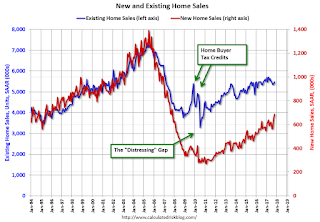by Calculated Risk on 11/27/2017 11:10:00 AM
Monday, November 27, 2017
A few Comments on October New Home Sales
New home sales for October were reported at 685,000 on a seasonally adjusted annual rate basis (SAAR). This was well above the consensus forecast, and the highest sales rate since October 2007. However the three previous months were revised down (combined).
There was clearly some rebound following hurricane Harvey. Sales in the South were up sharply in both September and October, from August, and at the highest level since October 2007. Some contracts in the South, that would have been signed in August, were probably delayed until September and October. Also some people who lost homes, might have signed contracts for new homes in September and October (New home sales are counted when contracts are signed).
Sales were up 18.7% year-over-year in September.
Earlier: New Home Sales increase to 685,000 Annual Rate in October.

This graph shows new home sales for 2016 and 2017 by month (Seasonally Adjusted Annual Rate).
For the first ten months of 2017, new home sales are up 8.9% compared to the same period in 2016.
This was a solid year-over-year increase through October.
And here is another update to the "distressing gap" graph that I first started posting a number of years ago to show the emerging gap caused by distressed sales. Now I'm looking for the gap to close over the next several years.

Following the housing bubble and bust, the "distressing gap" appeared mostly because of distressed sales. The gap has persisted even though distressed sales are down significantly, since new home builders focused on more expensive homes.
I expect existing home sales to move more sideways, and I expect this gap to slowly close, mostly from an increase in new home sales.
However, this assumes that the builders will offer some smaller, less expensive homes. If not, then the gap will persist.

This ratio was fairly stable from 1994 through 2006, and then the flood of distressed sales kept the number of existing home sales elevated and depressed new home sales. (Note: This ratio was fairly stable back to the early '70s, but I only have annual data for the earlier years).
In general the ratio has been trending down since the housing bust, and this ratio will probably continue to trend down over the next several years.
Note: Existing home sales are counted when transactions are closed, and new home sales are counted when contracts are signed. So the timing of sales is different.


